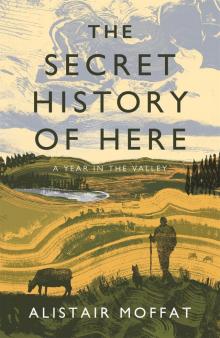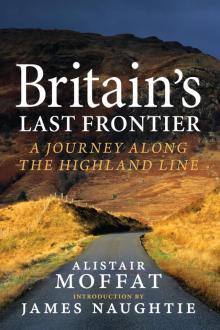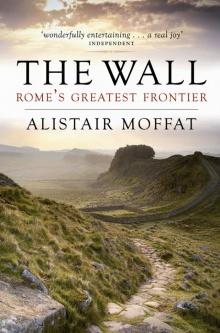- Home
- Alistair Moffat
The Secret History of Here Page 6
The Secret History of Here Read online
Page 6
24 January
Last night the snow came. The light in our bedroom told me that the land would be white. So that I could safely take the dogs out at 6 a.m. I pulled on boots with ice crampons attached, an essential precaution. At fifteen stone I fall hard, and the bumps, bruises and breaks linger longer. When I looked up from the snow and ice underfoot, waiting for the dogs to finish sniffing, the eastern sky was glittering, a silver dawn rising. The day looked as though it had been borne across the North Sea in the arms of angels.
The snow had made white roads through the grey, frosted grass and behind us my footprints were interwoven with Maidie’s tracks as she skittered and played, her white coat a camouflage except when her coal-black eyes and nose turned towards me.
Slowly the silver dawn turned to a rich red gold as the rising sun caught the undersides of the clouds, radiating, reaching far to the west and the setting moon. The gold glowed off the snow and made the dieback grass in the Top Wood look like ripening corn. Ten thousand dawns have been welcomed from where I stood but few can have arrived on such trails of glory. Mornings such as this make Heaven seem more than a metaphor.
26 January
Out on a blustery, damp morning to check on the horses who live out, I noticed all of them nibbling on the bitter winter grass, ignoring the forage heaped in their round feeders. There will have been little nourishment in the grass but they still preferred it. All of the snow had gone, the day was mild and the animals seemed content. Four of the horses are very old, one over thirty, and while they creak and probably have arthritic pain, they have the substantial consolation of living in an eternal present. Behavioural scientists believe that while horses have memory, and that is what makes them trainable, their overwhelming focus is on the here and now. Our Old Boys out in the East Meadow do not worry about the future and have forgotten almost all of the past.
Last night was magical, warming. For the first time in eight months all of our children and their spouses and partners were together to celebrate my younger daughter’s birthday. While I cooked what my adult children still call a birthday tea and others dished out drinks, the dogs and my granddaughter entertained everyone, basking in the love that wrapped around them. It was wonderful on a winter’s night to hear the house ringing with laughter.
27 January
‘Let the weight of the axe do it.’ So that the boy understood clearly, the man slowly swung the axe behind his shoulder in a short arc and turned a little as the blade bit into the birch tree. ‘And then you make a mouth,’ and he undercut the first blow so that a wedge of the white wood fell out. Once he had chopped several wedges, the man laid down the axe and stood with his back against the mouth and pointed. ‘That is the way the tree will fall. Now you need to cut the opposite side of the trunk.’
It is more than fifty years since an old forester showed me how to fell a tree, and it was advice I had cause to remember when my son and I cut down a wind-damaged Scots pine that threatened to fall across our track. Although I used a chainsaw to cut the mouth (having waited for a windless day) on the side opposite the direction I wanted the tree to fall, the principles had not changed. And they did not change for millennia. The old forester’s words echoed across sixty centuries of men and women working in the woods of the world.
Close to our farm, and especially on south-facing slopes near water, Walter Elliot has picked up or collected forty-eight prehistoric axe-heads. None of them had been knapped from local stone and most came from a place of great mystery and majesty. The jagged ridge of the Langdale Pikes in the Lake District was the quarry that produced most of the axe-heads Walter found. High up near the summit ridge, in difficult and dangerously precipitate places, miners hacked out nodules of tuff, a very hard volcanic rock. Even though there were much more accessible and easily worked deposits on the lower slopes, they chose to climb much higher to swing their antler picks. No practical reason for this can be deduced.
When the evening sun falls behind the Langdale Pikes, it backlights them black against the sky. Majestic, dramatic, the ridge may have seemed to our ancestors to be closer to the gods. Perhaps they risked the dangers of the sky quarries because they believed the axe-heads they carried down the mountainside would be blessed in some way. And perhaps that mattered because when the prehistoric foresters swung their axes they were doing the work of the gods and changing the world.
Sometime around 4000 BC the Wildwood began to be cleared. Trees were felled and scrub and bush burned back to open up the landscape. The greatest revolution in human history was underway. Farmers had come to Britain. The conventional historical record is silent about the beginning of farming, the sowing of crops and the domestication of animals. There are no recorded events, only very approximate dates, no named individuals, no battles and no conventional archaeology. Evidence for this revolution can only be found on the land and in our bodies.
Pollen analysis undertaken at Blackpool Moss, about two miles west of our farm, showed that the trees of the Wildwood – oak, elm, birch and hazel – were being cut down from about 4000 BC onwards. The Mason brothers began to find concentrated scatters of debris from flint knapping, including fragments of axe-heads, on south-facing slopes that often led down to boggy, flat areas or lochans. The Wildwood was being cleared and the tools to do it being manufactured in numbers.
Studies of ancestral DNA strongly suggest that farming and all of its techniques was brought by immigrants, most of them men. The most common Y chromosome marker in Britain, found from Shetland to Cornwall, is R1b, and its wide distribution and overwhelming numbers showed how successful the first farmers were. Our south-facing paddocks run down to what was the Hartwood Loch and because they were free-draining they were good places to plant the early, primitive cereals cultivated by the R1b men.
The settled peace and beauty of this place has filled the hearts and eyes of five hundred generations of hunters, gatherers and farmers, and sometimes in the early morning or the late evening, when the veil between worlds is thin, I feel them walk beside me.
28 January
Perhaps economic circumstances will force me to follow in the furrows ploughed by my ancestors but for the moment what I do is better described as small-scale husbandry. Using the wood that grew here, and having planted about three hundred trees since we arrived, I am husbanding that resource at least. And by beginning to grow garden crops in a small way, I am using the land to support us. Leaving aside any matters of principle or continuity, what I grow, the potatoes and tomatoes, taste a great deal better than anything that can be bought in a shop. I enjoy watching plants grow from seed and, in the future, I shall expand our raised beds and indoor planting.
29 January
Porridge changed the world. This is not an absurd Scottish nationalist fantasy but the conclusion of an attractive conjecture, something I have been thinking about as I work on the farm and try to bring life to its long past.
It is very probable that hunter-gatherer populations expanded extremely slowly, often only replacing generations, each couple having only two children. There were compelling reasons for this. Families found it difficult to move quickly and easily around the summer Wildwood with more than one or two children in tow. If one little one could walk, the other could be carried papoose-style, like Native Americans.
The second reason is more complex. The hunter-gatherer diet of meat, roots, fruits and berries is difficult for baby teeth to chew; some of the mothers in the tribes of the Amazon masticate their toddler’s food to break it down before putting it into their hungry mouths. For many millennia, the principal source of protein was breast milk and it is likely that prehistoric babies and toddlers were suckled for much longer than they are now, perhaps up to four years. Women are generally infertile while nursing young ones and so the birth interval in hunter-gatherer society might have been long. Given that the fertile lives of women were brief, with most dying at about the age of twenty, it seems very probable that two or at most three babies (who survive
d) might be born in each generation. For aeons, our ancestors flitted through the Wildwood, barely rustling the leaves of five thousand autumns.
When primitive cereals were grown, it is likely that, as well as making flour for unleavened bread, the pounded ears were mixed with water or animal milk to make a version of porridge, a loose paste that could be fed to young children that was high in protein and did not require to be chewed.
This in turn meant that babies could be weaned more quickly and that even in their brief, fertile lives women could have more children. The population began to grow rapidly and this was, I believe, the most important effect of the introduction of farming. The south-facing slopes of our fields, catching most of the sun, would have been good places to grow the small yields of cereals needed for prehistoric porridge and bread.
The other vital skill brought by the first farmers was the ability to domesticate animals, principally sheep and cattle. Both produced milk and once again this was a valuable food resource, especially for children. More than ten thousand years ago, human beings lost the ability to digest milk after weaning, but the early farmers overcame this by a process of natural selection and lactose intolerance was much reduced. This gave rise to a largely stock-rearing economy. I believe that our ancestors grew few crops but raised many sheep, cattle and some goats. The landscape around us still favours pastoralism and, like most of my neighbours, we mainly grow grass.
The dependence of the first farmers on their animals shaped a different sort of year, one that revolved around their rhythms, and they lived by what might be called the cattle clock. When pregnant cows and ewes began to feed their young, it signalled the end of the winter, and when the ancient journeys of transhumance led beasts and men up the hill trails, summer was starting. To relieve pressure on the inbye fields, herds and flocks were driven up country to fresh pasture, where shepherds and their dogs lived out with them, mainly protecting young animals from wolves. They lived in temporary structures called shielings. Our little valley is so perfect for these ancient practices that my neighbour still moves his stock around in similar ways. From the fields around Hartwood Loch, flocks and herds were driven up to the western hills behind Hartwoodmyres. And up in the Deer Park there are two scoops cut out of the limestone which look as though they might have served as shelters or shielings. There is no other reason for them being there.
30 January
In the circle of firelight faces flicker, staring at the flames. Sheep pelts from the autumn kill are pulled tight against the chilly draughts and the cone of sticks and split logs crackles as the father pokes at them. Wool combed from the summer ewes has made yarn woven into warm wraps for the little ones. Outside, the winter winds whistle and the world shrinks. Stories are told: how last year’s lambs sat on their mothers’ backs and how the calves cavorted and broke down the pens, how a coracle capsized on the loch and all the eels escaped, how springtime would come, and always tales of the spirits of the woods and the water.
As the little ones become drowsy, hunkering down below the lingering smoke, the father piles the fire with slow-burning whole logs and the flames die down to embers. In the chill of the long nights, the mother wakes often and turns the logs so that the embers glow and the hut warms a little.
Each morning I light the smaller woodburner and fill it with split logs left in the basket from the day before. Once it is roaring, the dogs, full of their breakfast, lie down on the sheepskins around it. My mood lifts as the dancing flames burn yellow and the wood crackles. The most urgent chore is to go out to the log barn to fill up the baskets, and this morning I had to use the axe to chop logs smaller so that they burned faster. Behind a row of orange Scots pine, I found an abandoned mouse nest the size of a shoebox. Its intricately woven moss and horse hair must have been the work of many days, the woodland mice gathering it up and slipping through to the back of the log piles to their secret home. Given the breeding rate of mice, it had been home to many. When I took the split logs that had been stacked around it back to the house, Maidie became very excited. But when she found no signs of prey, only their pungent scent, she lay back down in front of the fire and dreamed of rabbits in the springtime.
31 January
It was so cold this morning that the metal field gates were sticking and had to be kicked to free the catches. A low, dense grey mist muffled the land and hid the tops of the old sycamores. I could hear roosting crows cackling, nagging and shifting, but they were invisible. Even though there was no snow, a deep frost had made all white, stiffening the grass and turning the hawthorn hedges ghostly, a graphic, filigree tangle. Out in the East Meadow, the Old Boys and the mares stood motionless, heads down, recovering from the chill of the bitter night. Only the red blinking light of the electric fencing relieved the monochrome landscape. All was still, silent, waiting.
February
1 February
The land remembers the first farmers. Its contours carry memories of change and of continuity. Six thousand years ago, when the prehistoric peoples of our valley began to clear the tangle of the Wildwood, their great labour made them choose with care. Hacking down trees with the razor-sharp Langdale axes and burning back the bush and scrub was only worthwhile if the little fields were free-draining, sheltered and south-facing into the circuit of the sun. Our grass park below the Top Track and my neighbour’s beyond it were good places to grow barley and oats. They now drain down to the stream known as the Common Burn, our southern boundary. When the first fields were cleared, the run-off would have gone into Hartwood Loch.
When the new geometry of fields and enclosures was created, the effort involved must have changed attitudes to the land. Rather than the customary rights to their ranges, probably only rarely defended by the small bands of hunter-gatherers in the sparsely populated landscape, the farmers developed a firmer sense of ownership. None of this is more than conjecture, but it is likely, given the sustained effort required to make the fields.
No one knows what language the new farmers spoke, or indeed that of the peoples they largely supplanted. My own belief is that they brought early versions of Celtic languages, what evolved into Gaelic and Welsh. Whispers of the names they gave their places may survive on the modern map. Long before Gaelic came, dialects of Old Welsh were spoken in Scotland, and not far from our valley are some echoes of a different linguistic past, a different way of seeing a wilder, arboreal world. Near the village of Maxton is Pirnie, and it simply means ‘the wood’. Cognate is Primside in the foothills of the Cheviots, ‘the settlement by the white tree’, and across in Berwickshire is Printonan, ‘the wood by the moss or the bog’. There is not a shred of evidence to support this, but I like to think something like Printonan was the first name for our farm.
2 February
For millennia we have looked upwards. Each morning the enduring drama of the sky – the source of light, warmth, storm and lightning – has made us all pause to lift our eyes, not only farmers but millions of commuters and city dwellers on their way to work, on the school run, walking a dog or putting out the rubbish. We famously use the weather as a greeting or a way of opening conversation, but what we are really talking about is the sky, the wide blue yonder.
The place to see it in our valley is the Howden Motte. Steep-sided, it is a promontory that sits at the western end, overseeing all, commanding very wide vistas, about a mile from our farmhouse. Not too far for my little dog, I decided to walk up there and test a new interpretation. Called a motte because it was thought to have been the site of a Norman motte-and-bailey castle of the eleventh or twelfth century, it might in fact be much older. From a visit made some time ago, I had come to believe that it was originally a Bronze Age hillfort, dug and enclosed around 1500 BC.
To reach the old track that shelves into the flanks of the promontory the motte sits on, Maidie and I had to ford the Hartwoodburn. Very unwilling to splash across, her undercarriage being low to the ground, the little terrier dug in her paws on the bank and I had to lift her ac
ross. Embarrassing.
Once on the winding track I could see that the site is tremendously impressive, with very precipitate slopes to the south and north, and a gentle ridge leading from the east and up out of our valley. To the west the land falls away sharply down to the burn and the sparkling, tumbling waterfall of Motte Linn.
I could see that the site had been clearly man-made or man-enhanced, earth mounded up to make it even more commanding. But immediately on passing through the western gateway I realised that this was no Norman motte. There is a perfectly preserved example in Hawick, only ten miles away, and I know it well. It resembles an upturned pudding bowl, very simple and effective in its construction, designed as a refuge of last resort, resistant to cavalry, so steep it is difficult to scale. But at Howden, clearly visible through the leafless trees and the winter dieback, was evidence of much more. This fort was multi-vallate, with at least two more ditches visible on the steeper sides and probably others that had been ploughed out in the fields to the west and east. And certainly from the gentle slope in the east there would have been little protection from a concerted charge of cavalry. The top of the site was also too large for a Norman motte. Hawick and others I have seen are much smaller and more restricted. This place had been built not a thousand years ago but three thousand.
Surrounded by a screen of hardwood trees that have sent deep roots down through the looser soil of the banks and ditches, the interior of the hillfort was flat and looked to be about an acre in area. A low bank around the edges seemed to me to have been a later adaptation of this wonderfully well-positioned site, and in 1302 there is a record of a ‘fortalice’ built near Selkirk whose description fits. Beyond an eastern gateway that may not have been original, there are the ruins of a rubble-built cottage, perhaps eighteenth or early nineteenth century. A strange place to build a house, with a water source a long way away at the foot of a steep slope, it seemed a bleak location on this windswept day. Maidie climbed and scrambled over the fallen stones, looking for rabbit holes.

 The Secret History of Here
The Secret History of Here The Night Before Morning
The Night Before Morning To the Island of Tides
To the Island of Tides Arthur and the Lost Kingdoms
Arthur and the Lost Kingdoms Britain’s Last Frontier
Britain’s Last Frontier The Faded Map: The Lost Kingdoms of Scotland
The Faded Map: The Lost Kingdoms of Scotland The Wall
The Wall